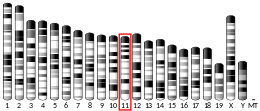RHAMM
| HMMR | |||||||||||||||||||||||||
|---|---|---|---|---|---|---|---|---|---|---|---|---|---|---|---|---|---|---|---|---|---|---|---|---|---|
| Identifiers | |||||||||||||||||||||||||
| Aliases | HMMR, CD168, IHABP, RHAMM, Hyaluronan-mediated motility receptor, hyaluronan mediated motility receptor | ||||||||||||||||||||||||
| External IDs | MGI: 104667 HomoloGene: 8271 GeneCards: HMMR | ||||||||||||||||||||||||
|
|||||||||||||||||||||||||
|
|||||||||||||||||||||||||
|
|||||||||||||||||||||||||
|
|||||||||||||||||||||||||
| Orthologs | |||||||||||||||||||||||||
| Species | Human | Mouse | |||||||||||||||||||||||
| Entrez |
|
|
|||||||||||||||||||||||
| Ensembl |
|
|
|||||||||||||||||||||||
| UniProt |
|
|
|||||||||||||||||||||||
| RefSeq (mRNA) |
|
|
|||||||||||||||||||||||
| RefSeq (protein) |
|
|
|||||||||||||||||||||||
| Location (UCSC) | Chr 5: 163.46 – 163.49 Mb | Chr 11: 40.7 – 40.73 Mb | |||||||||||||||||||||||
| PubMed search | |||||||||||||||||||||||||
|
|
|||||||||||||||||||||||||
NM_012485
NM_001142556
NM_001142557
NM_012484
NP_001136028
NP_001136029
NP_036616
NP_036617
Hyaluronan-mediated motility receptor (HMMR), also known as RHAMM (Receptor for Hyaluronan Mediated Motility) is a protein which in humans is encoded by the HMMR gene. RHAMM recently has been also designated CD168 (cluster of differentiation 168).
RHAMM was originally discovered as a soluble protein that altered migratory cell behavior and bound to hyaluronan. RHAMM is less well studied than the main hyaluronan (HA) receptor, CD44. In contrast to CD44 and other cell-surface receptors which contain the classical membrane spanning domain and signal sequence for secretion from the endoplasmic reticulum / Golgi complex, RHAMM does not contain a membrane spanning domain nor does the mRNA transcript contain a signal sequence. RHAMM is localized inside the cell and is unconventionally exported to the cell surface in response to certain defined stimuli such as wounding and cytokines including TGF-β. The precise unconventional export mechanism for transporting RHAMM to the extracellular space is still unclear but may involve transport channels or proteins, flippase activity, or exocytosis, similar to other non-conventionally exported cell surface proteins such as BFGF1,2 and epimorphin.
...
Wikipedia






